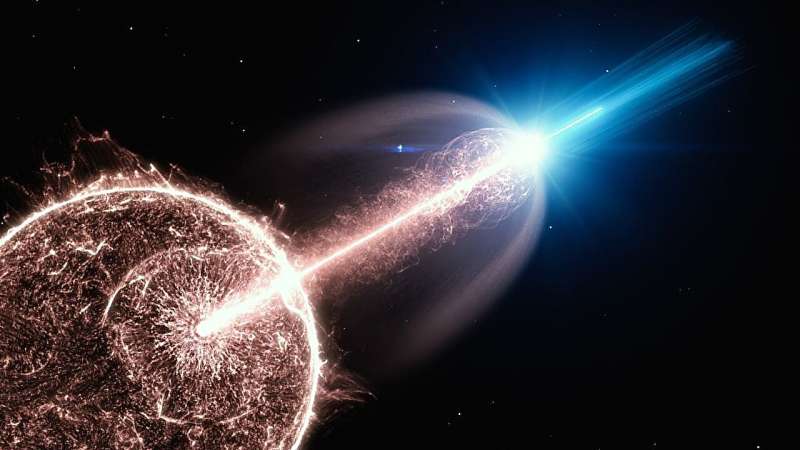This article has been reviewed according to Science X's editorial process and policies. Editors have highlighted the following attributes while ensuring the content's credibility:
fact-checked
preprint
trusted source
proofread
A gamma ray burst lasted so long it triggered a satellite twice

Gamma ray bursts (GRBs) are the most powerful astrophysical phenomena in the universe. For a span of seconds to a few minutes, they can be the most powerful high-energy event in the sky, shining across billions of light years.
But recently astronomers detected a GRB that lasted more than a thousand seconds, with two blasts of gamma rays that triggered the Fermi Gamma Ray Burst Monitor. It's such a strange cosmic event that astronomers aren't sure what caused it, but they do have a possible idea. They released their findings on the pre-print server arXiv.
Gamma ray bursts are difficult to study because they are so short-lived. They were first detected by the Vela satellites, which were designed to detect nuclear tests during the cold war. It was only years after their detection that they were declassified.
While their flash of gamma-ray energy is short-lived, GRBs also emit an afterglow that can be seen in radio and other wavelengths. So we have some ideas about their source. Most of them occur billions of light-years from Earth and are likely caused by the death of extremely massive stars.
The burst of gamma rays is emitted when the star collapses to form a black hole. Some GRBs may also be caused when neutron stars collide to create a black hole. It's the extreme gravitational collapse that powers GRBs, but this also means their highest energy bursts are short-lived. So how could one possibly last for more than 15 minutes?
Based on observations of the afterglow, the progenitor star isn't likely to have been something strange or exotic. The afterglow pattern is consistent with other minutes-long GRBs. So it's only the length and double-burst nature of the GRB that's unusual. And that may be the key to understanding it. One possibility is that the GRB was gravitationally lensed by a massive object.
Gravitational lensing occurs when light from a distant object is gravitationally warped by a galaxy or other object between us and the distant object. This would focus the GRB light, making it appear bright for a longer period of time.
Gravitational lensing can also create multiple images of an object. For example, light from a supernova can be lensed along different paths around a galaxy, letting us see the flash of light several times over the course of decades. A smaller lensing effect could explain why we saw two gamma-ray flashes. They could be the same GRB light lensed along different paths.
We'd need to observe similar strange GRBs to fully understand the cause, but this does show that the diversity of GRBs is broader than we thought. These powerful events still have lots to tell us about the cosmos.
More information: S. de Wet et al, The ultra-long GRB 220627A at z=3.08, arXiv (2023). DOI: 10.48550/arxiv.2307.10339
Journal information: arXiv
Provided by Universe Today



















